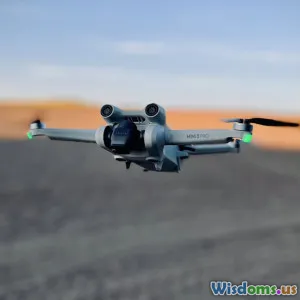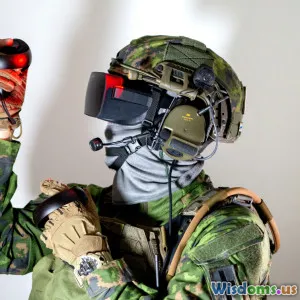
Biggest Challenges Facing Drone Countermeasures in Modern Armies
10 min read Explore the critical challenges modern armies encounter in deploying effective drone countermeasures amid evolving threats and technological complexities. (0 Reviews)
Biggest Challenges Facing Drone Countermeasures in Modern Armies
Introduction
In the past decade, drones have swiftly transformed from niche tools to ubiquitous elements of modern warfare. Their versatility, affordability, and disruptive potential have compelled armies worldwide to develop specialized countermeasures. However, this evolving battlefield dynamic creates a set of formidable challenges. Governments and militaries are racing to develop and deploy drone countermeasures that are not only effective but adaptable to an ever-changing threat landscape.
This article examines the intricate challenges military forces face today in countering drones. We will explore issues ranging from detection difficulties, regulatory concerns, technological evolution of drones, to operational and ethical dilemmas. By dissecting these challenges, we can better understand the state of military defenses against one of the most transformative technologies in warfare.
I. Detection Difficulties in Complex Environments
1. Small Size and Low Radar Signature
One of the core challenges in drone countermeasures is the detection of drones themselves. Modern drones are often small, lightweight, and constructed with materials that significantly reduce radar reflectivity, such as carbon fiber and plastic composites. For example, microdrones used for reconnaissance may have a wingspan of just a few centimeters, which makes them nearly invisible to traditional radar systems designed to detect larger aircraft.
This low radar cross-section requires armies to develop advanced sensor fusion systems, combining radar with infrared, acoustic, and visual detection technologies to reliably identify drones. The U.S. Department of Defense has invested heavily in multi-sensor fusion platforms, but these remain costly and can be prone to false positives due to clutter in urban and battlefield environments.
2. Electronic Countermeasures and Evasive Flying Patterns
Adversaries use sophisticated electronic warfare (EW) measures that complicate detection. Drones may operate under radio silence to avoid signals that can be traced or jammed. In some cases, autopilot systems preprogrammed with evasive maneuvers further frustrate detection efforts. For instance, terrorist groups in Syria and Iraq have employed drones flying erratically at low altitudes to avoid enemy sensors, as reported in conflict analyses from 2018-2022.
These tactics require countermeasure systems to have rapidly adaptive tracking algorithms capable of distinguishing hostile drones from friendly or civilian UAVs in chaotic battlefields.
II. Rapid Technological Evolution and Proliferation
1. Constant Innovation in Drone Capabilities
Drone technology is advancing at an unprecedented pace. Newer models boast longer endurance, greater payload capacity, enhanced stealth features, and increasingly autonomous operation enabled by AI and machine learning. For example, China's DJI has developed drones capable of autonomous swarm behavior, making traditional counter-drone tactics less effective.
Military research labs face continuous pressure to update counter-drone systems to keep pace. What was effective last year may be obsolete today, creating logistical and financial burdens. Programs like the U.S. Multi-Domain Task Force’s efforts to rapidly field newer countermeasures reflect this urgency.
2. Proliferation Among Non-State Actors
The widespread availability of commercial off-the-shelf drones means that non-state actors and insurgents now harness aerial capabilities once limited to state militaries. The inexpensive nature of hobbyist drones rapidly converted into military-capable platforms complicates threat assessment and response.
A notable example is the use of drones by the Houthi rebels in Yemen. Their attacks on Saudi oil infrastructure in 2019 demonstrated how relatively inexpensive commercial drones, modified with explosive payloads, can inflict significant damage. Military counter-drone strategies must thus accommodate a vastly broader threat spectrum – from highly sophisticated enemy UAVs to low-cost, improvised aerial munitions.
III. Legal, Ethical, and Regulatory Challenges
1. Restrictions on Jammer Use and Kinetic Interception
Most modern drone countermeasures fall into two categories: electronic (jamming, spoofing) and kinetic (shooting down or capturing drones). However, each comes with its own set of legal and ethical constraints.
Electronic countermeasures such as GPS spoofing or RF jamming can inadvertently interfere with civilian communications or GPS-dependent infrastructures, causing collateral disruption. This is particularly challenging in urban environments where drones operate near sensitive communication networks.
Meanwhile, kinetic options like firing guns, missiles, or deploying nets risk collateral damage from downed drones crashing into populated areas. As a result, militaries often apply strict Rules of Engagement (ROE) to minimize risks to civilians but these can limit effectiveness against fast-moving threats.
2. Integration with Domestic and International Law
International humanitarian law and national regulations impose restrictions on drone countermeasure deployment, especially within allied or civilian-controlled airspace. For example, the European Union Aviation Safety Agency (EASA) and the FAA in the United States regulate drone traffic and countermeasure use to ensure airspace safety.
Military commanders must navigate complex legal frameworks that sometimes lag behind technological advancements. This often causes operational delays or constrains countermeasure options, requiring close cooperation between defense agencies, law enforcement, and civil aviation regulators.
IV. Operational and Logistical Limitations
1. Cost and Scalability of Countermeasures
Deploying effective counter-drone systems across large or contested battlefields remains costly. Systems like the Israeli IronBeam laser defense or the U.S. Army's Counter-Rocket, Artillery, and Mortar (C-RAM) platforms require significant investment in infrastructure, training, and maintenance.
Low-cost drone swarms used by adversaries present the risk of saturation attacks, overwhelming single-point counter-drone defenses. Ensuring scalable, cost-effective coverage demands advances in autonomous defense drones and AI-enabled detection systems that can simultaneously monitor vast airspaces.
2. Friendly Fire and Identification Challenges
Proper identification of drones is imperative to prevent friendly fire incidents. In crowded airspaces hosting allied UAVs conducting reconnaissance or logistics missions, distinguishing between friend, foe, and neutral drones is complicated.
Military forces employ Identification Friend or Foe (IFF) systems, yet drone swarms lacking standard transponders challenge these protocols. False positives not only waste resources but risk undermining operational cohesion and morale.
V. Emerging Solutions and Future Directions
Despite these challenges, modern armies are innovating to stay ahead. Developments include:
-
Directed Energy Weapons (DEW): High-energy lasers offer precise, low-collateral damage options to neutralize drones rapidly.
-
AI-Powered Multi-Sensor Systems: Combining radar, optics, and acoustics with AI improves detection and classification accuracy in complex environments.
-
Swarm Counter-Drone Drones: Autonomous interceptors that can chase and disable hostile drones autonomously, increasing scalability.
-
Regulatory Harmonization: Joint military-civilian efforts to develop clearer legal frameworks supporting safe counter-drone operations.
As drone technologies evolve, countermeasures must do so in a dynamic, integrated manner combining hardware, software, legal, and cooperative domains.
Conclusion
Drones represent a profound force multiplier and vulnerability in modern warfare. The biggest challenges facing drone countermeasures—from stealthy, agile threats and rapid tech evolution to regulatory, ethical, and operational constraints—demand comprehensive, adaptive solutions.
Understanding these challenges allows military planners, policymakers, and technology developers to innovate more effectively. This will be critical to maintaining airspace security, protecting troops and civilians, and preserving strategic advantages on future battlefields.
By embracing advanced AI-driven detection, scalable defense architectures, and international regulatory collaboration, modern armies can stay ahead of increasingly insidious drone threats.
The race between drone capabilities and countermeasures is accelerating—and success will require agility, foresight, and expertise across multiple domains.
Rate the Post
User Reviews
Popular Posts


















